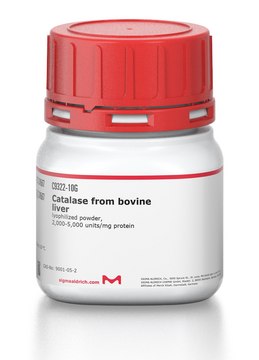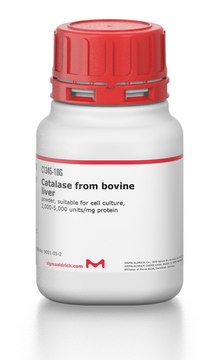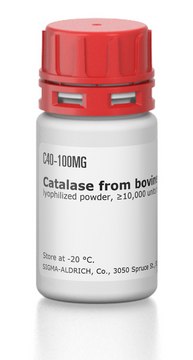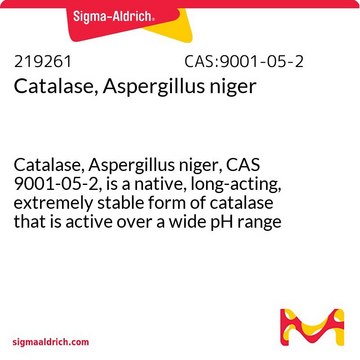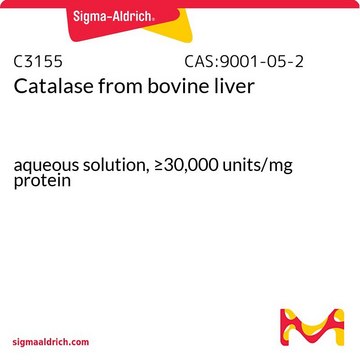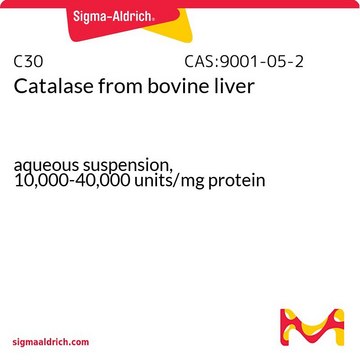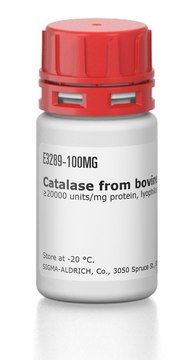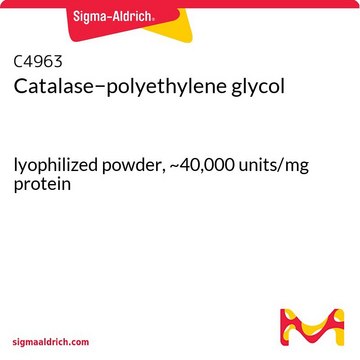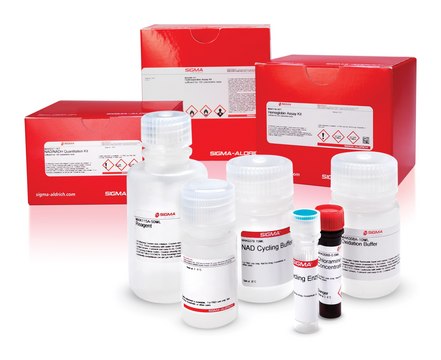C3556
Catalase from human erythrocytes
≥90% (SDS-PAGE), buffered aqueous solution, ≥30,000 units/mg protein
Synonym(s):
H2O2:H2O2 oxidoreductase
Sign Into View Organizational & Contract Pricing
All Photos(1)
About This Item
Recommended Products
biological source
human erythrocytes
Quality Level
Assay
≥90% (SDS-PAGE)
form
buffered aqueous solution
specific activity
≥30,000 units/mg protein
mol wt
tetramer ~250 kDa
concentration
≤10 mg/mL
technique(s)
cell based assay: suitable
UniProt accession no.
shipped in
wet ice
storage temp.
−20°C
SMILES string
O(CC)C(=O)c1ccc(cc1)O
InChI
1S/C9H10O3/c1-2-12-9(11)7-3-5-8(10)6-4-7/h3-6,10H,2H2,1H3
InChI key
NUVBSKCKDOMJSU-UHFFFAOYSA-N
Gene Information
human ... CAT(847)
General description
Research area: Cell Signaling
Human catalase is a member of the monofunctional heme-containing catalases. It is an intracellular enzyme located at higher concentrations in the liver, erythrocytes, and kidney. Catalase is a homo-tetrameric protein and comprises amino acid residues, one heme group that is iron III protoporphyrin IX, and a nicotinamide adenine dinucleotide phosphate (NADPH) molecule. It is a ubiquitous enzyme found in most aerobic organisms. The catalase (CAT) gene is located on the human chromosome at 11p13.
Human catalase is a member of the monofunctional heme-containing catalases. It is an intracellular enzyme located at higher concentrations in the liver, erythrocytes, and kidney. Catalase is a homo-tetrameric protein and comprises amino acid residues, one heme group that is iron III protoporphyrin IX, and a nicotinamide adenine dinucleotide phosphate (NADPH) molecule. It is a ubiquitous enzyme found in most aerobic organisms. The catalase (CAT) gene is located on the human chromosome at 11p13.
Application
Catalase from human erythrocytes has been used:
- to prevent reoxidation of reduced cytochrome c by H2O2 while measuring the production of superoxide with cytochrome C.
- as a component of the imaging buffer for stochastic optical reconstruction microscopy (STORM) imaging of human skin fibroblasts
- as a component of the gloxy mix for single-molecule imaging
Biochem/physiol Actions
Catalase activates the decomposition of hydrogen peroxide, a reactive oxygen species, into water and oxygen. It functions as a natural antioxidant, protecting cells against oxidative damage to proteins, lipids and nucleic acids. Catalase has also been used to study the role reactive oxygen species play in gene expression and apoptosis.
Deficiency of catalase and oxidative stress are associated with vitiligo, hypertension, Alzheimer′s disease, diabetes mellitus, and acatalasemia. Catalase shows a dichotomous role in cancer as its expression is at a higher level in chronic lymphocytic leukemia, glioma, melanoma, and gastric cancer and lower levels of expression are seen in acute myeloid leukemia, pancreatic, lung, prostate, and skin (non-melanoma) cancers.
Unit Definition
One unit will decompose 1.0 μmole of H2O2 per min at pH 7.0 at 25 °C, while the H2O2 conc. falls from 10.3 to 9.2 mM, measured by the rate of decrease of A240.
Physical form
Solution in 50 mM Tris, pH 8.0
Storage and Stability
Tightly closed. Dry. Keep locked up or in an area accessible only to qualified or authorized
persons
persons
Analysis Note
Protein determined by biuret
inhibitor
Product No.
Description
Pricing
Signal Word
Danger
Hazard Statements
Precautionary Statements
Hazard Classifications
Resp. Sens. 1
Storage Class Code
11 - Combustible Solids
WGK
WGK 1
Flash Point(F)
Not applicable
Flash Point(C)
Not applicable
Personal Protective Equipment
dust mask type N95 (US), Eyeshields, Gloves
Choose from one of the most recent versions:
Already Own This Product?
Find documentation for the products that you have recently purchased in the Document Library.
Customers Also Viewed
Our team of scientists has experience in all areas of research including Life Science, Material Science, Chemical Synthesis, Chromatography, Analytical and many others.
Contact Technical Service